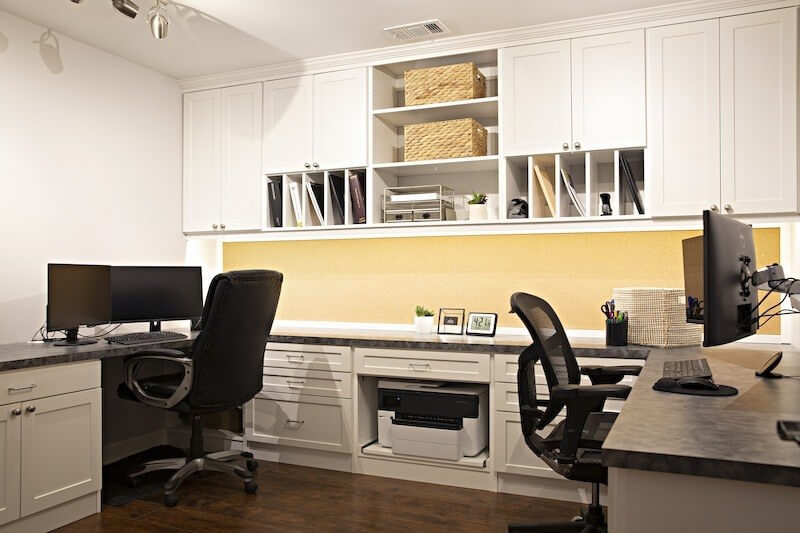With long spring days right around the corner (literally, this weekend!), we are seeking that fresh, clean feeling that comes with a home overhaul. There’s a reason we get an itch to clean this time of year, and it’s heightened this season with the KonMari method at the forefront of everyone’s minds — and Netflix queues. In hopes that we can relieve a little bit of that overwhelming feeling that comes with organization, we chatted with The Closet Company team here in Nashville. They offered their best tips for organizing and some creative solutions for common organization problems in the four most cluttered areas of the home, which include the pantry, closets, the garage and the home office.
Adam Floyd, founder of The Closet Company, suggests a week-by-week approach to tackle these four areas in three ways. “The first and best tip for spring cleaning is to decide how you want to use the space, how you want it to function and how you want it to feel.” Second, decide what can aid in that specific purpose and function (aka time to purge!). Finally, plan the space and purchase or configure the necessary organization tools you need to maintain a sense of order. The ultimate goal is long-term organization, so each individual step is crucial to keeping your space as tidy as possible. For that reason, we leave a full week per space for purging and organizing.
RELATED: The Consequences of Ignoring Home Maintenance (& a Handy Checklist to Help!)
WEEK ONE: THE PANTRY
The pantry clutters quickly. A space used by almost everyone in the household, it is difficult to monitor and maintain a sense of order. Because of this, it’s imperative to assign a place or shelf for each individual item — considering the frequency of use as well as the size of the item. Adam shares that his favorite pantry organization hacks are wine racks and wine storage, lazy Susans and/or spice racks for spices and countertops inside the pantry when possible.
Common Problems:
- Not enough shelving and lack of adjustability
- No dedicated spaces for large, awkward items like appliances, pet food, serving platters, etc.
- No compartmentalization of everyday items vs. occasionally used pieces
- Co-mingling of unrelated items
- “Blind” corners with unused space
Tips for Pantry Cleaning:
- Toss any expired snacks, spices or baking ingredients.
- Clean the shelves themselves while they’re empty.
- Designate space for daily items, like favorite spices, coffee, cereal, etc., close to the door for easy access.
- Group similar ingredients together.
- Use baskets or bins to store snacks for the kids and place them on lower levels of the pantry.
- Specify spots for serving platters, appliances, pet foods, etc. These should be farther back and out of the way or stored elsewhere.
- If you can, Adam recommends deep (16″ to 20″ when possible), adjustable shelving. This allows you to customize space for the items you need to store — with the ability to change as needed.
WEEK TWO: THE CLOSETS
Ah, the closet. More than just a place for shoes and clothes, closets are frequently the storage catch-alls — and therefore, frequently the most cluttered spaces in the home. When properly organized, they simplify mornings. When improperly organized, they breed stress. This second space, tackled during week two, will likely take the most time of all, but will provide the most payoff. The closet experts shared many of their unique offerings, like built-in vanities, mirrored cabinets to hold shoes and shelving, killer lighting and even islands for additional storage, but in the meantime, they left us with a few tips for a well-organized closet you can tackle yourself.
Common Problems:
- Poorly designed layout
- Inefficient construction using wire shelving or builder-grade material
- Not designed for the individual and their contents
- Ineffective separation of “his” and “hers”
- Lack of functional accessories
Tips for Closet Cleaning:
- Donate or discard each item that has not been worn or used in the last year.
- Remove items that don’t belong.
- Categorize clothing, by color, by frequency of wear, by type of garment, by season or some combination of those.
- Fold and store sweaters on shelving or in drawers.
- Incorporate special accessories like jewelry cabinets, hampers, tie/belt racks, scarf hangers, etc.
- Clearly separate belongings if multiple people use the closet.

WEEK THREE: THE GARAGE
It’s easy to let a garage get a little out of hand. Out of sight, out of mind, as they say. However, this space is ideal for larger storage and, with some careful planning, it can serve its homeowners well. Ryan shares that a few of their favorite unique ideas for garage organization include kayak/bike/ladder hoists to lift big items off the floor, incorporating a TV cabinet above a work-station (though we can’t promise this will increase productivity out there!) and using a pegboard to get items like tools off the floors. When you tackle the garage, keep the size and weight of items in mind.
Common Problems:
- There is little or no vertical storage.
- Things are left and forgotten.
- Shelving isn’t large enough or deep enough to accommodate larger items that live in the garage.
- Without proper storage, boxes pile up cluttering the space and defeating its utility.
Garage Cleaning Tips:
- Throw out old items that have been forgotten and unnecessary junk.
- Separate remaining items into categories to be stored: tools, holiday, automotive gear, outdoor/sport equipment and miscellaneous.
- Clean the empty space.
- Use shelving and clear plastic bins to store items based on frequency of need. Seasonal decor should be stored up top, while daily tools within safe arm’s reach.
- Store heavier items, even seasonal, on the ground and use shelving for lighter items.
WEEK FOUR: THE HOME OFFICE
You’ve almost made it! It is the final week of spring cleaning, and now you’ll be able to enjoy this season in a clutter-free home. Your last step is the home office. While it might not be a full room in your home, there’s certainly a space you can tackle where all of that paper, mail and junk piles up. In this room or area, consider the true purpose of the space. Do you work there every day? Do your kids use the space for homework? Is it lacking functionality because the printer doesn’t work anymore? Take these things into consideration as you declutter and organize with purpose.
RELATED: Dysfunctional to Functional: My Home Office Transformation
Common Problems:
- Not enough cabinet or drawer space
- Small countertops with wires everywhere
- No logical place for filing paperwork
- Computers and printers not designed into the structure
Home Office Cleaning Tips:
- Discard trash, old bills, expired coupons, dried out pens or other random notes.
- Sort papers into categories and file them in folders or drawers that are specifically, purposefully marked.
- Invest in ample shelving or drawers to store desk supplies and papers – only leaving the most important accessories exposed on the desktop.
- Consider risers for computers to create empty space and wire organizers to keep chargers and power cords tidy.

And there you have it! A happy, organized home just in time for spring. Special thanks to The Closet Company for sharing their expert insight to aid in our spring cleaning endeavors.
*****
And for your newly decluttered home, find interior design inspiration here!




















